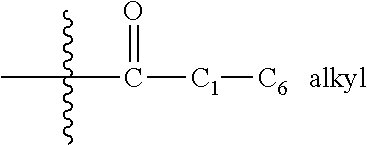Piperidin-4-yl-azetidine diamides as monoacylglycerol lipase inhibitors
a technology of monoacylglycerol and piperidin, which is applied in the direction of biocide, drug composition, organic chemistry, etc., can solve the problem of difficult to separate the beneficial effects of these compounds from the unwanted side effects
- Summary
- Abstract
- Description
- Claims
- Application Information
AI Technical Summary
Benefits of technology
Problems solved by technology
Method used
Image
Examples
example 8
[0201]
[0202]A. Methyl 1-(3,4-difluorophenyl)-indole-5-carboxylate, 8b. A mixture of methyl indole-5-carboxylate 7a (2 g, 11.4 mmol), 1-iodo-3,4-difluoro-benzene 8a (1.5 mL, 12.5 mmol), CuI (0.22 g, 1.14 mmol), trans-N,N′-dimethylcyclohexane-1,2-diamine (0.54 mL, 3.43 mmol), and K3PO4 (6.06 g, 28.5 mmol) in toluene (12 mL) was heated at 110° C. for 7 h. The reaction mixture was diluted with CH2Cl2 and filtered. The solution was concentrated and the residue was purified by flash column chromatography (silica gel, 20% EtOAc / heptane) to give 3.0 g of compound 8b. MS m / z 288.1 (M+H+).
[0203]B. 1-(3,4-Difluorophenyl)-indole-5-carboxylic acid, 8c. A mixture of methyl 1-(3,4-difluorophenyl)-indole-5-carboxylate 8b (3.0 g, 10.4 mmol) and LiOH (1.0 g, 41.8 mmol) in THF (120 mL) and H2O (60 mL) was stirred at room temperature for 5 days. Aqueous 10% HCl solution was added to the reaction mixture to adjust pH=3˜4. The resulting mixture was extracted with EtOAc (2×). The organic solution was wash...
example 9
[0209]
[0210]A. Methyl 4-((4-fluorophenyl)amino)-3-nitrobenzoate, 9c. A mixture of methyl 4-fluoro-3-nitrobenzoate 9a (1 g, 5.02 mmol), 4-fluoroaniline 9b (4.34 mL, 5.02 mmol), and DIPEA (1.04 mL, 6.03 mmol) in DMF (10 mL) was stirred at room temperature for 2 h. Water was added to the mixture, the resulting solid was collected by filtration, washed with water, and dried. The crude compound 9c was used in the next reaction without further purification.
[0211]B. Methyl 3-amino-4-((4-fluorophenyl)amino)benzoate, 9d. A mixture of compound 9c (1.4 g, 4.8 mmol) and SnCl2.2H2O (4.9 g, 21.7 mmol) in EtOH (50 mL) was stirred at 80° C. After 4 h, the mixture was cooled to room temperature and was slowly added to saturated aqueous NaHCO3. The solid was collected by filtration and washed with H2O. The solid was triturated with EtOAc and the filtrate was concentrated. The crude compound 9d was used in the next reaction without further purification. MS m / z 261.1 (M+H+).
[0212]C. Methyl 1-(4-fluorop...
example 10
[0219]
[0220]A. Methyl 2-methyl-1-(4-fluorophenyl)-1H-benzo[d]imidazole-5-carboxylate, 10a. The title compound 10a was prepared using the method described in Example 9, substituting trimethyl orthoacetate for trimethyl orthoformate in Step C. The crude compound 10a was used in the next reaction without further purification. MS m / z 285.1 (M+H+).
[0221]B. 2-Methyl-1-(4-fluorophenyl)-1H-benzo[d]imidazole-5-carboxylate, 10b. The title compound 10b was prepared using the method described in Example 9, substituting compound 10a for compound 9e in Step D. The crude product 10b was used in the next reaction without further purification. MS m / z 271.2 (M+H+).
[0222]C. 1-(4-Fluorophenyl)-2-methyl-5-({3-[1-(1,3-thiazol-2-ylcarbonyl)piperidin-4-yl]azetidin-1-yl}carbonyl)-1H-benzimidazole, Cpd 87. The title compound Cpd 87 was prepared using the method described in Example 9, substituting compound 10b for compound 9f in Step E. The crude product was purified by preparative reverse phase chromatograp...
PUM
| Property | Measurement | Unit |
|---|---|---|
| temperature | aaaaa | aaaaa |
| temperature | aaaaa | aaaaa |
| temperature | aaaaa | aaaaa |
Abstract
Description
Claims
Application Information
 Login to View More
Login to View More - R&D Engineer
- R&D Manager
- IP Professional
- Industry Leading Data Capabilities
- Powerful AI technology
- Patent DNA Extraction
Browse by: Latest US Patents, China's latest patents, Technical Efficacy Thesaurus, Application Domain, Technology Topic, Popular Technical Reports.
© 2024 PatSnap. All rights reserved.Legal|Privacy policy|Modern Slavery Act Transparency Statement|Sitemap|About US| Contact US: help@patsnap.com










